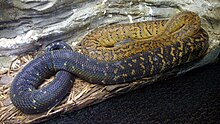Chilabothrus
| Chilabothrus | |
|---|---|

| |
| Cuban boa, C. angulifer | |
| Scientific classification | |
| Kingdom: | Animalia |
| Phylum: | Chordata |
| Class: | Reptilia |
| Order: | Squamata |
| Suborder: | Serpentes |
| Family: | Boidae |
| Subfamily: | Boinae |
| Genus: | Chilabothrus Duméril & Bibron, 1844 |
Chilabothrus, commonly known as the Greater Antillean boas or West Indian boas,[1] is a genus of nonvenomous snakes in the subfamily Boinae of the family Boidae. The genus is endemic to the West Indies. 14 species are recognized as being valid.[2][3]
Distribution[]
Species of Chilabothrus are found throughout the West Indies, from the Lucayan Archipelago to the Virgin Islands and all four of the Greater Antilles.[3][4]
Species[]
| Species[1] | Taxon author[1] | Subsp.*[1] | Common name(s) | Geographic range[4] |
|---|---|---|---|---|
| , & , 2021 | 0 | Hispaniolan vine boa | Hispaniola (Dominican Republic[5]) | |
C. angulifer |
(Cocteau & Bibron, 1840) | 0 | Cuban tree boa[1] | Cuba and adjacent islands (including Isla de la Juventud, Archipiélago de los Canarreos in Cayo Cantiles, Archipiélago de los Colorados off the northern coast of Pinar del Río, and Archipiélago de Sabana-Camagüey on Cayo Guajaba and Cayo Sant María), as well as The Bahamas. |
| C. argentum | Reynolds, , , & , 2016 | 0 |
Conception Bank silver boa[6] |
Conception Island Bank, The Bahamas |
C. chrysogaster
 |
(Cope, 1871) | 1 | Turks and Caicos Islands boa | Lucayan Archipelago, including the Turks and Caicos Islands (on Grand Turk Island, Middle Caicos, North Caicos, Big Ambergris Cay, Little Ambergris Cay and Long Cay) and The Bahamas (on Great Inagua Island and Sheep Cay). |
C. exsul
 |
(Netting & Goin, 1944) | 0 | Abaco Islands boa | Grand Bahama Island, Great Abaco Island, Elbow Cay and Little Abaco Island, The Bahamas |
| C. fordii | (Günther, 1861) | 2 | Ford's boa, Haitian ground boa | Hispaniola (in both Haiti and the Dominican Republic) and adjacent islands (Île de la Gonâve, Isla Saona and on Lake Enriquillo) |
| C. gracilis | Fischer, 1888 | 1 | Hispaniola (in both Haiti and the Dominican Republic), north of the Plain of the Cul-de-Sac. | |
| (Stull, 1933) | 0 | Virgin Islands tree boa | The British Virgin Islands (on Great Camanoe, Necker, Tortola and Virgin Gorda), Puerto Rico (on Culebra and Cayo Diablo) and the United States Virgin Islands (on Saint Thomas).[7] | |
C. inornatus |
(Reinhardt, 1843) | 0 | Puerto Rican boa[1] | Puerto Rico |
C. monensis |
(Zenneck, 1898) | 1 | Mona Island boa[1] | Mona Island and Cayo Diablo, Puerto Rico, as well as the United States Virgin Islands (on St. Thomas) and the British Virgin Islands (on Tortola, Great Camanoe, Necker and Virgin Gorda). |
| C. schwartzi | (, 1975) | Acklins boa[1] | Acklins Island and Crooked Island in The Bahamas | |
C. striatus |
(Fischer, 1856) | 7 | Hispaniolan boa | Hispaniola (in both Haiti and the Dominican Republic) and adjacent islands (Île de la Tortue, Île à Vache, Saona) |
| (Cope, 1863) | 0 | Bahamian boa[1] | The Bahamas | |
C. subflavus |
(Stejneger, 1901) | 0 | Jamaican boa[1] | Jamaica (including Goat Island) |
*) Not including the nominate subspecies.
T) Type species.[4]
Nota bene: A taxon author in parentheses indicates that the species was originally described in a genus other than Chilabothrus.
References[]
- ^ a b c d e f g h i j "Chilabothrus". Integrated Taxonomic Information System. Retrieved 6 July 2008.
- ^ Chilabothrus at the Reptarium.cz Reptile Database. Accessed 22 September 2020.
- ^ a b , (2018). "Boas of the World (Superfamily Booidae): A Checklist with Systematic, Taxonomic, and Conservation Assessments". Bulletin of the Museum of Comparative Zoology. 162 (1): 1–58. doi:10.3099/MCZ48.1.
- ^ a b c McDiarmid RW, Campbell JA, (1999). Snake Species of the World: A Taxonomic and Geographic Reference, vol. 1. Washington, District of Columbia: Herpetologists' League. 511 pp. ISBN 1-893777-00-6 (series). ISBN 1-893777-01-4 (volume).
- ^ , Reynolds RG, Henderson RW (2021). "A small new arboreal species of west Indian boa (Boidae: Chilabothrus) from southern Hispaniola". Breviora (571): 1–20. (Chilabothrus ampelophis, new species).
- ^ (2016). "Silver Boa: Scientists Discover New Snake Species in Bahamas". Sci-News.com. Retrieved 2016-06-01.
- ^ (2021). "Chilabothrus granti ". The IUCN Red List of Threatened Species 2021: https://dx.doi.org/10.2305/IUCN.UK.2021-2.RLTS.T7829A18979910.en. Downloaded on 11 September 2021.
Further reading[]
- Duméril A-M-C, Bibron G (1844). Erpétologie générale ou Histoire naturelle complète des Reptiles, Tome sixième [Volume 6]. Paris: Roret. xii + 609 pp. (Chilabothrus, new genus, pp. 562–563). (in French).
| Wikimedia Commons has media related to Chilabothrus. |
Categories:
- Chilabothrus
- Snake genera
- Taxa named by Gabriel Bibron
- Taxa named by André Marie Constant Duméril
- Snakes of the Caribbean